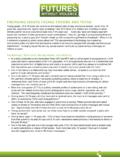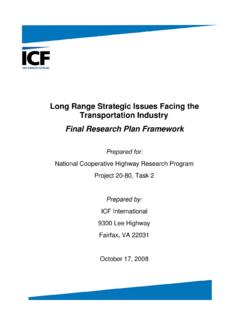Transcription of Brief No. 4 EMPLOYMENT Legal Briefings - Great Lakes
1 Legal Briefings EMPLOYMENT Brief No. 4 April 2008 Prepared by: Barry C. Taylor Legal Advocacy Director, Equip for Equality 1 Disability Harassment, Retaliation and Discipline Three emerging ADA Issues An employee with a disability is called platehead and other derogatory names by co-workers after returning to work after brain surgery. Is such conduct actionable as disability harassment under the ADA? An employee with a disability files with the EEOC after her employer refuses to accommodate her. Six months later she is terminated. Is there a sufficient causal connection between filing with the EEOC and the termination to give rise to claim of retaliation under the ADA?
2 An employee with post-traumatic stress disorder violates a professional conduct rule and is disciplined by his employer. The employee claims that the discipline should be rescinded once the employer learns of his disability. Is there a basis for an ADA claim for improper discipline against an employee with a disability? These scenarios raise questions about three emerging ADA issues: Disability Harassment, Retaliation and Discipline. All three of these issues are complex and provide challenges for employers and employees. This Legal Brief will examine the nature of these different Legal theories under the ADA and how courts have interpreted them. Disability harassment under Title I of the ADA is a developing area of law, and this cause of action is being explicitly or implicitly recognized by a growing number of courts.
3 The Supreme Court and the lower federal courts have previously recognized a cause of action for workplace harassment under Title VII of the Civil Rights Act of 1964 (Title VII), which prohibits discrimination in EMPLOYMENT on the basis of race, color, religion, sex, or national origin. See 42 2000e-2(a)(1) I. Introduction II. Disability Harassment 2 Disability Harassment, Retaliation and Discipline Three emerging ADA Issues A review of Title VII harassment cases reveals that there is no exact science to determining what conduct rises to the level of actionable harassment. The courts, however, have set a high bar for what conduct constitutes harassment under Title VII.
4 Courts that have recognized a disability harassment claim under Title I of the ADA have analogized such a claim to a Title VII harassment claim. As more and more individuals with disabilities enter the workforce, the more important this issue will become for employers. Training and anti-harassment policies that address other forms of harassment, based on race and sex, for example, should be modified to include disability. A. Disability Harassment Claims Under Title I of the ADA Title I of the ADA prohibits discrimination in EMPLOYMENT , and provides employees with disabilities with broad protections in the workplace. The statute states: No covered entity shall discriminate against a qualified individual with a disability because of the disability of such individual in regard to job application procedures, the hiring, advancement, or discharge of employees, employee compensation, job training, and other terms, conditions, and privileges of EMPLOYMENT .
5 See 42 12112 (a) Courts that have recognized a cause of action for disability harassment have focused on the similarities between this provision of the ADA and Title VII. Although harassment is not expressly prohibited in Title VII, the Supreme Court has recognized that harassment based on a protected status is implicitly prohibited by Title VII. Both Title I of the ADA and Title VII use the language terms, conditions, and privileges of EMPLOYMENT . Courts have interpreted this to be the relevant portion of the statutes from which to draw a harassment claim. The courts have established that, should conduct rise to a level that is severe and pervasive, and creates an abusive work environment that interferes with an employee s ability to perform the job, it is a form of discrimination, because it adversely effects the terms and conditions of that individual s EMPLOYMENT .
6 The Supreme Court has not yet addressed harassment under the ADA, but lower federal courts have either expressly recognized or presumed that the ADA also includes a cause of action for harassment based on disability since Congress was aware of the Supreme Court s interpretation of terms, conditions, and privileges of EMPLOYMENT under Title VII when it enacted the ADA. Four federal circuit courts of appeal have ruled that disability harassment/hostile work environment claims are actionable under Title I of the ADA. Many other circuits have presumed that the cause of action exists, but have not yet explicitly issued a ruling that a disability harassment claim is actionable under the ADA.
7 Further, numerous federal trial courts have either recognized the claim or presumed that the claim exists. Significantly, no federal court has ruled that a disability harassment claim is not actionable under Title I of the ADA. B. The Legal Standard for Disability Harassment Courts recognizing a claim for disability harassment have adopted the Title VII analysis for harassment or hostile work environment claims, slightly modified to reflect that the claimed harassment is based on disability. Courts have held that, to establish a hostile work environment claim under the ADA, a plaintiff must prove that: 1. Plaintiff is a qualified individual with a disability; 2.
8 Plaintiff was subjected to unwelcome harassment; 3. The harassment was based on plaintiff s disability; 4. The harassment was sufficiently severe or pervasive to alter a term, condition, or privilege of EMPLOYMENT ; and 5. Some factual basis exists to impute liability for the harassment to the employer ( the employer knew or should have known of the harassment and failed to take prompt, remedial action) Brief No. 4 April 2008 Disability Harassment, Retaliation and Discipline Three emerging ADA Issues 3 In disability harassment cases, as in sexual harassment cases under Title VII, plaintiffs frequently have had difficulty establishing the fourth element, that the harassment was severe or pervasive enough to alter a term, condition, or privilege of EMPLOYMENT .
9 The case summaries below contain several examples of factual scenarios where employees asserted harassing conduct by co-workers and supervisors. Yet, in analyzing the facts and applying them to the Legal standards, even in the cases that led to a decision for the plaintiff, courts have differed in the requisite severity or pervasiveness necessary to conclude that there was a hostile environment or actionable harassment. Where the harassment causes tangible injury, however, the courts find it easier to hold that severe harassment occurred. In many cases, verbal insults, intimidation, or threats alone have not been sufficient to support a harassment claim.
10 It has taken years to set the parameters of harassment claims under Title VII, so this is clearly a developing area of law under the ADA. It should be noted that Section 504 of the Rehabilitation Act of 1973 (Rehab Act), which prohibits discrimination by entities that receive federal funding, applies in the EMPLOYMENT context. Because the ADA incorporates by reference many of the terms of the Rehab Act, courts have held that the standard for proving a disability harassment claim under the Rehab Act is parallel to that established under Title I of the ADA. The only additional element a plaintiff must show is that the employer is a recipient of federal funds.





